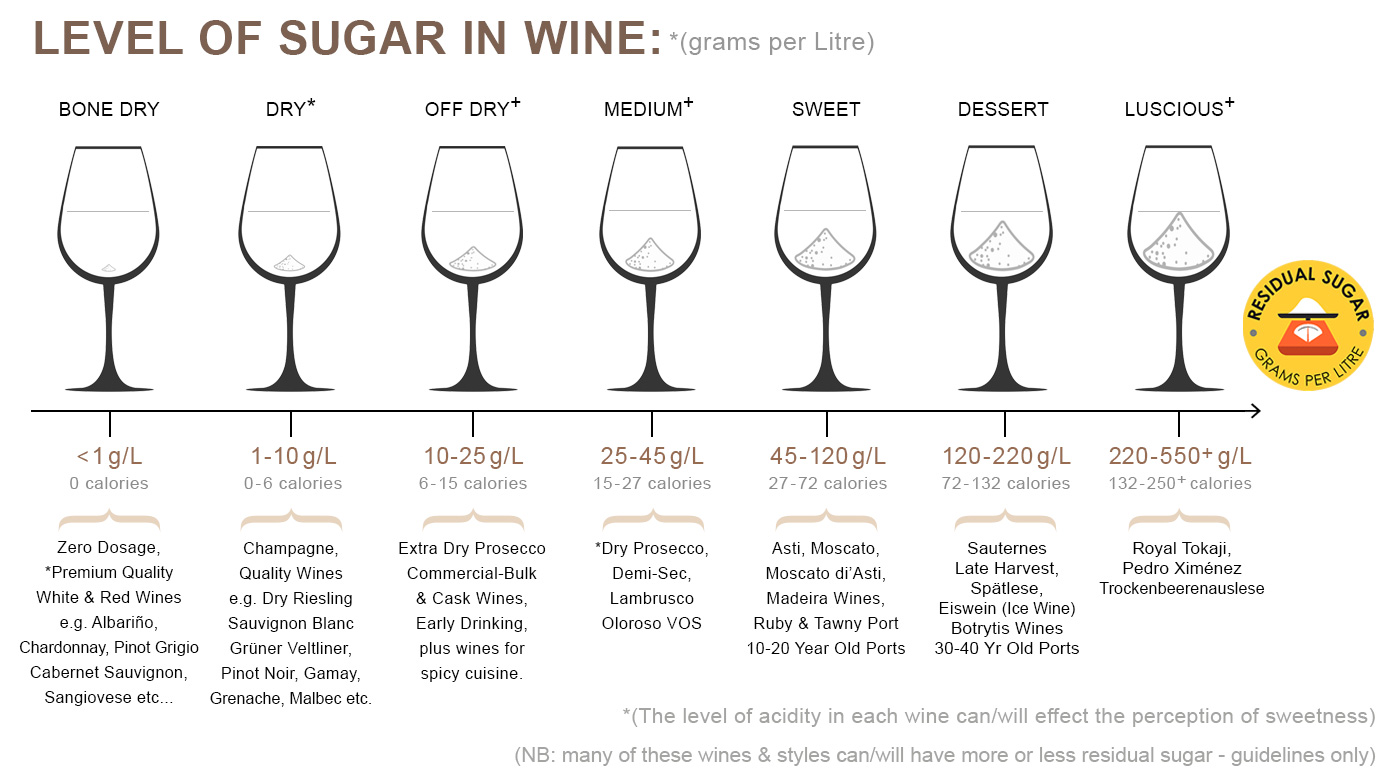Levels of Sugar in Wine:
Is there sugar in wine? Well, the answer is Yes & No.
Some wines have virtually no sugar - *(less than 1 gram per Litre), and others have a lot more (sometimes 2 - 3 times as much as a soft drink). Would you be surprised to learn that many commercial soft drinks have about the same level of sugar at 100 - 120g/L, as some sweet dessert wines. For example, a typical sweet ‘Late Harvest’ Riesling will have approximately 120g/L of residual sugar - *(NB: residual sugar is unfermented natural sugar in the finished wine, this is not added sugar)
Though it must be said early on - that a ‘level’ of sweetness is one’s perception. Like that of bitterness in a wine, like the caffeine in a cup of coffee, or tannins in wine will reduce the perception of sugar. So does the high level of natural acidity in a wine *(e.g. Riesling or Sauvignon Blanc) will reduce the perception of sugar. Hence the amount of phosphoric acid in your typical soft drink, and the importance of ‘natural fruit acidity’ in finished wine. Also - each of us have our own thresholds *(level of experience and comfort) with sweetness, but also for all flavours in beverages and cuisine.
So, for a winemaker trying to make a well-balanced Riesling, Pinot Gris or Gewürztraminer, or any wine with residual (unfermented) sugar, the key is the balance between sweet and sour (natural sugars and fruit acidity). This vinification balancing act is one of the toughest in winemaking and not all wines get it right.
So just to be completely clear - the sugar in 'still wines' is called residual sugar or RS on the tasting note. Please understand this sugar does not come from added corn syrup or granulated sugar, but from the natural sugars found in wine grapes that include fructose and glucose. For example, many grape varietals when all their juice is pressed out and before fermentation starts can have around 240g/L of natural sugar, as you require 17-18 grams of sugar to get 1 degree* of alcohol.
During winemaking, yeast is added to the fruit juice and the organism typically converts the sugar into alcohol (this is the by-product of fermentation) making a dry wine - *(i.e. fermented dry, converting all the natural sugars to alcohol - so no sugar is left). However, sometimes and deliberately a winemaker, will decide not all the sugar is to be fermented - leaving some sweetness left in the wine to balance the level of acidity for example.
Balance is also relative to the style and sometimes quality of a wine. For example, if you are wanting to complement the subtle flavours in a seafood salad a crisp dry white wine will be ideal pairing. But with the same dish an overly sweet dessert wine will not complement and possibly overwhelm the flavours. But if you have a slice of lemon meringue pie the opposite combination would be more ideal.
Many of you ask - where is the level of sugar on a bottle? Wineries are not required legally to disclose the level of sugar on a wine label - so you will need to visit their website and read the ‘Full Technical Tasting Sheet’ - or ask your fine wine retailer or restaurant wine waiter.
• Dry Wines: Both dry white and red wines will tend to have lower levels of residual sugar, typically at 1 - 3 grams of sugar per litre of wine.
• Champagne / Methode Traditionnelle: When it comes to sparkling wines typically most people enjoy Brut, or a growing trend is Extra Brut sparkling wines. The sugar levels *(dosage, added cane sugar) for Brut will be in the range of 6 - 12g/L. Extra Brut at 0 - 6g/L. Brut Nature being the driest and lowest in sugar content 0 - 3g/L.
• Off Dry to Medium Wines: These wines will vary greatly in their level of sweetness. Typically, these wines have a residual sugar range of 10 - 40g/L. But again the level of acidity can effect the perception of each wine.
• Fortified Wines: Port, Sherry & Marsala for example can have residual sugars of 90 - 120g/L - again these can and will vary greatly on style and quality.
• Sweet ‘Late Harvest’ or ‘Botrytis’ Wines: While certainly known for being a sweet treat for the taste-buds, and served with dessert. Botrytis wines can have a residual sugar of 150 - 200g/L (or more). Some very special, rare examples of Tokaji wine can be over 400g/L.

Other factors that can affect how sweet a wine tastes:
• The level of alcohol in a wine can add a perception of sweetness, with increased, elevated aromas of different fruits and a warm engagement around the palate.
• The level of natural fruit acidity plays its part in the actual taste and perception, as acidity causes salivation, it can balance, even out sweetness and prevent a wine from tasting flabby or tired.
• The level of tannins in a wine creates a drying effect on the palate and contributes to the texture and breath of a wine.
• Oak barrels mature and soften wines and when new or young, can impart flavours like coconut, vanilla and caramel.
